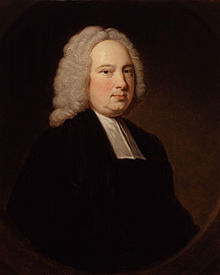James Bradley
James Bradley (born March 3, 1693 in Sherborne (Gloucestershire) , † July 13, 1762 in Chalford ) was an English clergyman and astronomer . He is considered a pioneer of precise astrometry and, with the annual aberration of the stars, was the first to demonstrate the movement of the earth around the sun.
Live and act
James Bradley was born in Sherborne near Cheltenham in Gloucestershire . From 1711 to 1718, he studied theology at Balliol College of Oxford . In 1719 Bradley became Vicar of Bridstow and his friend, MP Samuel Molyneux , gave him a benefice in Wales .
Interest in astronomy
In addition to theology, Bradley was very interested in astronomy. He made his first observations under the guidance of his uncle, the accomplished amateur astronomer Reverend James Pound (1669-1724), at the Wanstead parish in Essex . In 1718 he was accepted as a " Fellow " in the Royal Society .
In 1721 Bradley was appointed to Oxford University, where he took over the Savilian Chair of Astronomy . He held u. a. Lectures on " experimental philosophy ", at that time the name for the new kind of natural science , in which the highest criterion of truth was no longer the philosophical principles, but the observations.
Scientific research
Bradley's specialty was astrometry , the position of stars. While observing the sky with a specially constructed zenith telescope , which he carried out with his friend Samuel Molyneux at his observatory, he discovered the phenomenon of the aberration of light on the star Gamma Draconis in 1725 , caused by the movement of the earth around the sun. This was a first proof of Copernicus' heliocentric worldview and also a way of determining the travel time of light for the astronomical unit . Bradley was able to determine this with an accuracy of 1%, while the results with the method devised by Ole Rømer still scattered by 10%. In the discussion of the results with the court astronomer Edmond Halley in 1728, in writing in January 1729, he points out that his method also shows the independence of the speed of light from the light source, direction and distance.
Through precise measurements of the moon's orbit over 19 years, Bradley also discovered the nutation of the earth's axis . He published the results of his observations in 1748.
In 1742 he was appointed to succeed Edmond Halley as " Astronomer Royal " and director of the Royal Greenwich Observatory . Under his direction, the instruments at the Greenwich Observatory were increased for the then immense sum of £ 1,000 . In 1750 a quadrant was commissioned by John Bird . In 1752 Bradley received an annual salary of £ 250 from the British Royalty.
In 1761 he had to resign from his offices for health reasons. He moved to Chalford, Gloucestershire, where he died the following year at Skiveralls House, aged 69.
Publication and significance of his research results
Bradley's stargazing release was delayed due to a copyright dispute . They were finally published in two volumes in 1798 and 1805. Friedrich Wilhelm Bessel reduced Bradley's records and created a star catalog with 3,000 stars.
James Bradley is seen as one of the founders of telescope-based astrometry and thus one of the most important astronomers of the 18th century.
Memberships
He was a member of the Royal Prussian Academy of Sciences since 1746. In 1748 he became a member of the Académie des Sciences and in December 1753 an honorary member of the Russian Academy of Sciences in St. Petersburg .
Eponyms
The asteroid (2634) James Bradley , discovered on February 21, 1982, has been named after him since 1985. Also is after him Mons Bradley named on the Earth's moon.
Fonts (selection)
- A Letter from the Reverend Mr. James Bradley Savilian Professor of Astronomy at Oxford, and FRS to Dr Edmond Halley Astronom. Reg. & C. Giving an Account of a New Discovered Motion of the Fix'd Stars . In: Philosophical Transactions . Volume 35, number 406, 1727, pp. 637–661, doi : 10.1098 / rstl.1727.0064 , ( full text )
- Hornsby / Robertson (eds.): Astronomical observations made at the observatory at Greenwich 1750–1762 . 2 volumes, Oxford 1798–1805. Supplement 1833.
Web links
- Entry to Bradley; James (1693-1762) in the Royal Society Archives , London
Individual evidence
- ↑ The Little Encyclopedia . Encyclios-Verlag, Zurich 1950, Volume 1, p. 221
- ↑ Historical Academicians: James Bradley. Berlin-Brandenburg Academy of Sciences, accessed on September 26, 2019 .
- ^ Foreign members of the Russian Academy of Sciences since 1724: Bradley, James. Russian Academy of Sciences, accessed September 26, 2019 (Russian).
- ↑ Minor Planet Circ. 9768
| personal data | |
|---|---|
| SURNAME | Bradley, James |
| BRIEF DESCRIPTION | English astronomer and pastor |
| DATE OF BIRTH | March 3, 1693 |
| PLACE OF BIRTH | Sherborne |
| DATE OF DEATH | July 13, 1762 |
| Place of death | Chalford |
